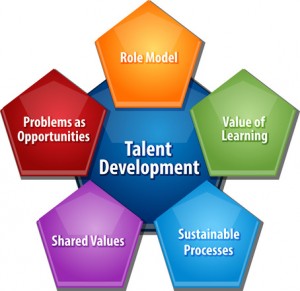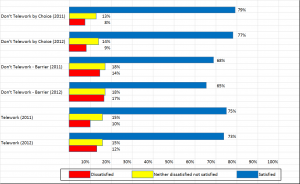Tip: 5 Tips for Being Happier at Work
 No matter how challenging and invigorating your work, we can all use a few ideas to clear our heads or get us thinking more positively. Try these on for size.
No matter how challenging and invigorating your work, we can all use a few ideas to clear our heads or get us thinking more positively. Try these on for size.
- Read daily affirmations. At the end of a weekly networking meeting, someone always has a positive quote for us. It works. We realize our capabilities and self-worth and it helps us stay motivated.
- Talk it out. I think this one works especially well for women – but don’t let that be your excuse to pass on this tip. Having a quick conversation with a friend, or setting the time aside to get a cup of coffee with a friend helps us work out difficulties.
- Conquering the big project. Sometimes just thinking about what’s on your plate can be overwhelming. The trick is to slice it up into several servings. Take the time to go over the project, decide what is needed, and break it up into smaller tasks.
- Go on silent. This is one of my favorite tips. Sometimes I just want to work my way through projects without interruption. Closing my door, putting my phone on silent, NOT opening my email – all of these tactics taken together give me a sense of power and ownership. I come away fulfilled.
- Don’t go it alone. Reach out to colleagues or friends. Talking over a project with someone else is sometimes all you need to make it clear in your own mind. And chances are, the person you talk to will even give you other ideas to consider.
Do you have a tip that works for you? Send us your tip by email and we’ll share in an upcoming blog post.
LMJA works with organizations, helping them focus on various challenges. If you need help with training or would like information on developing Individual Development Plans (IDP) for all levels of employees, give us a call at 301-670-0051, or email me at Leadership@lmja.com.
Effective Leading Starts with Listening!
 Remember when sales people used to push themselves on you? You’d go into a store and someone jumps right on top of you and starts telling you about the merchandise. It kind of makes you go wonky, doesn’t it? It’s very disconcerting and not very friendly. The first time I bought my own car it nearly rattled me. The sales person was mostly interested in getting a car off his lot than listening to me.
Remember when sales people used to push themselves on you? You’d go into a store and someone jumps right on top of you and starts telling you about the merchandise. It kind of makes you go wonky, doesn’t it? It’s very disconcerting and not very friendly. The first time I bought my own car it nearly rattled me. The sales person was mostly interested in getting a car off his lot than listening to me.
Thankfully, the better sales people have refined their trade. Instead of hanging all over you, they wait. They ask open ended questions. And they Listen.
The same holds true for leaders. Leaders who are interested in getting the work done understand that the key to success is enhancing the capacity and skills of those they work with. Leaders, in fact, coach. And in order to coach an employee to reach his/her highest potential, nothing is more important than how leaders listen, absorb what is said and give feedback.
Listening is a skill. It takes thought. We have to remind ourselves often to stop talking and just listen. Here are five rules to follow which will help develop the skill of listening effectively.
Listen with Interest. We’ve all had that occasion when we’re talking and yet clearly seeing that the person we’re talking to is not really listening to us. Instead, listen with the curiosity of someone who really is interested in what your employee is saying. Instead of thinking about what our feedback is going to be, stay focused on the topic. Keep interruptions to a minimum and move the conversation forward by keeping it on target.
Absorb what you hear. We can fake it sometimes. We can look like we’re interested but our minds are going elsewhere. Instead, take in what is being said. Register the emotion of the person who is talking to you. And be prepared to restate to the employee the discussion you’ve just had. If you do, you’ll stay in the conversation and not drift.
Restate the conversation accurately. Now, you’re showing the person that you really are listening. You not only demonstrate your commitment, but the person you’re talking to gets to “hear” how they sound. Is the message that was conveyed the message he/she really meant to convey?
Ask Questions. Asking questions promotes a fruitful dialogue. You’ve extended the conversation. And by asking open-ended questions, the person you are talking to might voice the answer you want to hear. In fact, you are empowering your employee to think it through. And you’re building their confidence.
Provide Feedback. Avoid preaching and bringing up past experiences. Instead, get clever. You want to be clear in your feedback, but you can also make it relevant and non-threatening. Make your feedback helpful and positive.
Are you a C1, C2, C3 or C4 communicator? LMJA can help your team self-identify their style and strengthen communication… and have fun! LMJA also help organizations with many common challenges – time management, project management, conflict management, strategic planning, to name a few. If you need help or would like to discuss your options, give us a call at 301-670-0051, or email me at Leadership@lmja.com.
Tips for Active Listening
 We all have times when we’re distracted. Or our emotions get in the way. Instead of listening, we find ourselves preparing a rebuttal. Here are some good tips for active listening. Try them and let us know how they work for you!
We all have times when we’re distracted. Or our emotions get in the way. Instead of listening, we find ourselves preparing a rebuttal. Here are some good tips for active listening. Try them and let us know how they work for you!
- Know your own communication style. If you are well aware of your style of communication, you’ll know what you need to do to create a lasting impression with other.
- Concentration. If you find it very difficult to concentrate on what is being said, try repeating their words mentally as they say them. This will help reinforce their message and keep you focused.
- Disturbance. If there is a “side” conversation going on in the office, move. Try a quieter room or find a spot in another part of the room.
- Repetition. Use reflective words so that your interpretation of the conversation is correct. For example, use words such as: “What I’m hearing is. . .” and “Sounds like you are saying. . .”
- Emotional Distraction. If you find yourself reacting emotionally to what someone said, admit it. Ask for more information or for better clarity.
- Interruption. Finally, allow the person speaking to you to finish each question before you answer. Don’t interrupt.
LMJA works with organizational challenges. If you need help or would like to discuss your options, give us a call at 301-670-0051, or email me at Leadership@lmja.com.
Competency Modeling
 Is competency modeling part of your strategic plan? More and more organizations are using competency modeling to define successful performance in a particular work setting. Here’s an overview of competency modeling – what it means and what are the benefits of competency modeling.
Is competency modeling part of your strategic plan? More and more organizations are using competency modeling to define successful performance in a particular work setting. Here’s an overview of competency modeling – what it means and what are the benefits of competency modeling.
Competencies are individual characteristics. Competencies are often the basis for skill standards. They include the knowledge, skills, abilities, self-image, traits, mindsets, feelings, and even the ways of thinking with regard to appropriate roles. These competencies lead to a desired result – they contribute to exemplary performance that in turn, creates an impact on the outcome of the organization.
In short, a competency is the framework for defining the skill and knowledge requirements of a job.
What is a competency model? A competency model is a list of characteristics that together define successful performance in a particular work setting.
Competency models can be developed for specific jobs. They are widely used in various industries to define and assess competencies – in both hard and soft skills.
How does competency modeling differ from job analysis? The aim of competency modeling is not to summarize how a job has been performed in the past, but rather to identify the behaviors that will be needed to achieve long-term strategic goals. In this sense, competency modeling is forward looking and not rooted in the past.
What are the benefits of competency modeling. Competency models are considered valuable by various organizations to define skill and knowledge requirements of specific jobs, to assess competencies and performances, and help set business strategy. They also help reveal strengths and weaknesses – which help form the basis for training programs and learning content, both formal and informal.
In general, organization that adhere to competency modeling report:
- Greater alignment with business objectives.
- Enhanced productivity.
- Increased workforce nimbleness.
- Improved ability to identify and develop high achievers.
- Better retention of top talent. |
Experts also recommend that competency models receive sponsorship from senior leaders, are aligned to the organization’s business strategy and culture, are based on research and are tied to talent management practices.
For more information on Competency Modeling and Training, contact LMJ&A at leah@lmja.com. We can help your organization successfully employ competency modeling in the workplace. Working with you step-by-step, we will support and guide your organization through each component of the process. Give us a call at 301-670-0051.
TIP: The Elements of a Competency Model
Though the elements of a model vary, there are usually three main components.
- A title and definition. A title might consist of “Being a team player.” The definition should describe what a team player should be. Descriptions could include “Treating others with courtesy, Working to resolve conflicts, etc.”
- Descriptions of activities or behaviors. Link the description to the competency. In this case, what are the activities and behaviors of a team player? The list might include “Capitalizing on strengths of others, Motivating others to contribute, etc.”
- A diagram of the model. A diagram helps everyone visualize the competency and grasp the model. You can see various models diagrammed on this page.
For more information on Competency Modeling and Training, contact LMJ&A at leah@lmja.com. We can help your organization successfully employ competency modeling in the workplace. Working with you step-by-step, we will support and guide your organization through each component of the process. Give us a call at 301-670-0051.
Finding Purposeful Work
 My friend Rachel always told her kids that they would probably have 3-4 careers during their lifetimes. Having worked in the same field my entire life, that always seemed like odd advice. It felt to me that she was giving her kids the privilege to jump around, to try different jobs and different companies. Would they ever settle down? I mean really, what’s wrong with one line of work?
My friend Rachel always told her kids that they would probably have 3-4 careers during their lifetimes. Having worked in the same field my entire life, that always seemed like odd advice. It felt to me that she was giving her kids the privilege to jump around, to try different jobs and different companies. Would they ever settle down? I mean really, what’s wrong with one line of work?
Somewhere along the way, I discovered what she meant. Rachel always strived to find meaningful work. For her, meaning and purpose are core motivators. That thinking is validated by Daniel Pink, author of “Drive” whose book examines 50 years of behavior science to get at the real truth around human motivation. Rachel has always been wired to find work that is meaningful. Now, I wanted that. My job had become less than satisfying and I wanted to feel like I was doing something important.
I mentioned my struggle to Rachel and she said, “Try something different!” She said to me that she thought people changed as they went through life. Things take on different levels of importance during different times. And that’s why she told her kids that they would probably have more than one career. Finances take on different meanings. Families change. Our needs change. And our values change too. We want our jobs and our lives to take on different meanings.
It’s true, that trying something different can have drastic results. We have responsibilities. Most of us need to be fiscally responsible. We can’t just “check out!”
What is meaningful work? I had to do a bit of soul searching. What was I looking for? I thought that meaningful work meant being paid for work that I love. And in my case, that meant creating value for others. I wanted to gain the respect of my peers and find value in what I do. Meaningful work, I was sure, would make me happy. Here’s what I learned.
Rungs Of A Ladder. Finding meaningful work can be a process. For some, it may mean that we take on a second job, or we volunteer after work. We find something that we are passionate about – something that gives us pleasure and makes us feel good about ourselves. The rungs of a ladder work parallel to each other. This is true of our job and our purpose in life. For most of us, as we seek meaningful work, what we do for a living and what we are passionate about often run parallel to each other. But as we strive for meaningful work and focus on our vision, they often merge.
What if you haven’t found purposeful work yet? How do you start? Is it possible to find meaningful life without quitting your job? Finding meaningful work is a process. There are things we can do to help us determine what is purposeful.
- Take time to stop. Think about what you are doing and whether or not it satisfies your need to provide value.
- Rethink your position. As we grow, as we age, things shift. You may find that what was very important at one time, is no longer important. Is your job still purposeful?
- Know that your search for meaningful work may not be a straight path. We have obligations we can’t ignore. We may be pressured to follow a certain path. And we may be competitive – with ourselves and others. The trick is to exercise patience and don’t give up.
- Tune into the mission of your work / organization. Depending on the mission, you might see something that is essential for enhancing your purpose in life.
- Set reasonable goals and then realize what you’ve accomplished, even if it’s taking longer than you wanted.
- Perform random acts of kindness. Helping someone lifts a mood and adds purpose. That might mean taking a meal over to a family where someone is going through medical issues. It might mean helping a co-worker on a project.
- Take time for mental thinking. Focusing on the future and planning your next move help to keep us on track.
- Develop a code of ethics to live by. Establish values you can uphold.
- Volunteer a portion of your time to something you are passionate about.
The steps we take now help us stay more positive. And as we become more positive, we leap over obstacles.
Want to find purposeful work? Try these tips.
 Millennials are good examples – they choose meaningful work over money. Millennials often have two jobs – one that brings in money, and one that is meaningful. Often, when people take this route to finding purposeful work, the source of income and the source of meaning start to merge. Millennials are also good at multi-tasking, so they thrive on variety.
Millennials are good examples – they choose meaningful work over money. Millennials often have two jobs – one that brings in money, and one that is meaningful. Often, when people take this route to finding purposeful work, the source of income and the source of meaning start to merge. Millennials are also good at multi-tasking, so they thrive on variety.
There are many benefits to purposeful work, including psychological wellness, productivity and creativity.
Generally speaking, finding purposeful work depends on four contributions:
- Give back. By serving others, you find purpose.
- Contribute to family. Identifying how you can best serve your family and close friends brings enjoyment.
- Commit to the future. We need to grow. Practicing self-improvement in order to reach a better future motivates us.
- Code of ethics. Develop a set of values and steadfastly follow them.
Finding the passion to contribute to yourself, your family and friends, as noted above, moves you forward to a future of purposeful work.
Tip: The Secret to SMART Goals
Most goals aren’t SMART – not because they are hard to write, but because most people don’t ask enough questions. Follow these steps to create clear and specific goals!
- Write your goal. Then ask: Is this goal as detailed as you can make it?
- Define how you will measure your progress. Do the steps you’ve created set a clear path from where you are today to where you want to be?
- In order for a goal to be achievable, there should be periodic checkpoints leading up to the goal. What milestones can you expect to reach to ensure that the goal you set stays on track?
- Make sure that you have the tools you need to accomplish your goal. Is training needed? Does your employee have time to do the necessary work? What will you do if individuals don’t respond?
- Set a date to reach your goal – one that is reasonable and within reach. Do you have updates scheduled during that time period? It’s more likely that the goal will be accomplished if there are intermediate activities that must be met.
When goals are achieved in the workplace there’s a feeling of control and fulfillment. Employees are more likely to feel empowered and more satisfied in their work. If you need help setting SMART goals to achieve standards mandated throughout your organization, please give us a call at 301-670-0051. Let’s discuss your needs.
Telework – What Happens?
 What happens when employees telework? Since telework has become an important organizational change, not only in the Federal Government but also in the private sector, it’s important for all organizations to envision the success of the effort and measure the results. In a recent report, “Status of Telework in the Federal Government – Report to Congress,” the US office of Personnel Management noted an improvement in employee attitude as a result of telework capabilities.
What happens when employees telework? Since telework has become an important organizational change, not only in the Federal Government but also in the private sector, it’s important for all organizations to envision the success of the effort and measure the results. In a recent report, “Status of Telework in the Federal Government – Report to Congress,” the US office of Personnel Management noted an improvement in employee attitude as a result of telework capabilities.
Measuring the Improvement in Employee Attitude. The Federal Employment Viewpoint Survey (FEVS) shows the potential for telework to influence important employee attitudinal and perceptual variables. The survey looked at employees who telework, those who don’t because of a barrier of some sort, and those who do not telework by choice. Demonstrated in the report is the value of autonomy – “I get to make the decision, to telework or not.” When employees have a choice, job satisfaction increases. Those employees who face barriers to telework reported lower job satisfaction scores. Typically, their attitudes toward the organization and their supervisors are less positive.
Academic research indicates that telework program participants are more likely to exhibit job satisfaction and improved performance. The FEVS survey noted similar findings. There was a larger percentage of teleworkers who reported satisfaction with their jobs than those who were not able to telework. In 2011, those figures were 75% vs 68%, and in 2012 the figures were 73% vs 65%. The survey seems to suggest that existence of telework policies benefits the entire workforce in indirect but positive ways.
In the 2012 FEVS survey, 68% of the respondents reported satisfaction with their jobs. And 15% reported dissatisfaction. The results also show that there is a decline in the percentage of job satisfied employees between 2012 (68% ) and 2011 (71%). This general decline is also reflected in a comparison of teleworker job satisfaction data – reporting 68% job satisfaction in 2011 and 65% in 2012.
Please click on the chart below for more information on job satisfaction.
Successful Teleworking Tips
Successful Teleworking
 In order for Teleworking to be successful, there should be a plan. When there is, it’s obvious that the agency wants it to work. Certainly, they don’t want telework to negatively impact careers. We uncovered a few tips for successful teleworking.
In order for Teleworking to be successful, there should be a plan. When there is, it’s obvious that the agency wants it to work. Certainly, they don’t want telework to negatively impact careers. We uncovered a few tips for successful teleworking.
- Keep your work relationships intact. Touch base with your team members often. Reschedule your commuting days as needed. Get feedback weekly from your supervisor. And make sure he/she knows your career goals.
- Keep your career on track. Make the important meetings, even if it means changing your schedule. Be flexible. And review your emails – be sure they are tactful and diplomatic. Update your status often and take credit when it’s appropriate. Be clear about your career goals.
- Set rules. It’s easy to be too available at home. It’s up to you to set work hours, when and how you can be interrupted and what areas are off-limits. And while you’re setting rules, make a schedule and stick to it. When you telework, it’s easy to slack off without thinking, or you can become a workaholic. Neither option is good. Balancing your work and home life, as much as you can, will make you happier and more productive. And your telework plan will be successful.
In a report to the Congress on the status of telework in the Federal Government, efforts to promote telework were reported. READ MORE on the effectiveness of agency-wide telework efforts.

